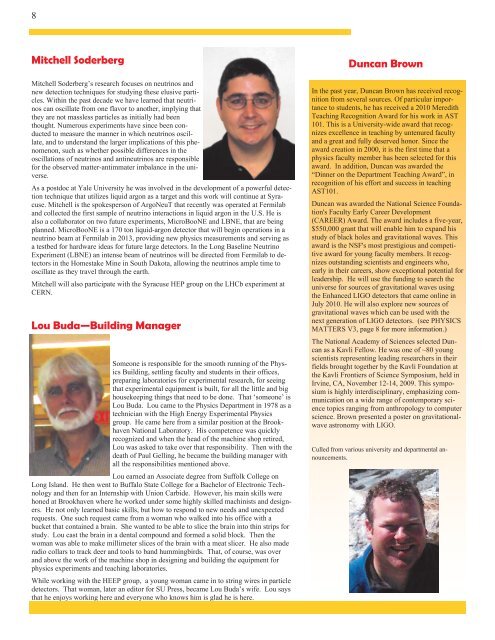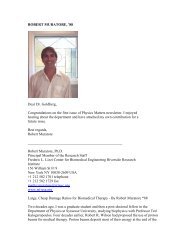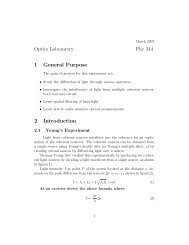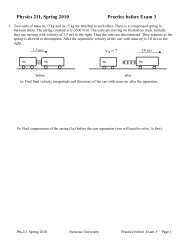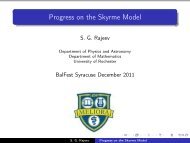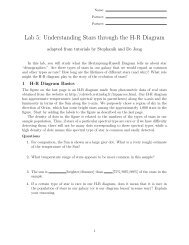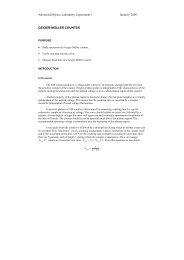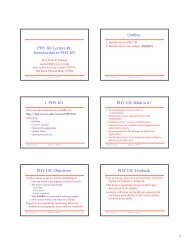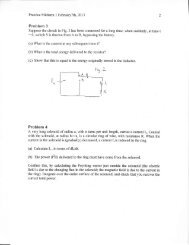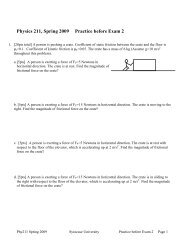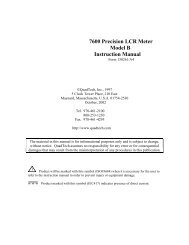Volume 5 - Physics - Syracuse University
Volume 5 - Physics - Syracuse University
Volume 5 - Physics - Syracuse University
Create successful ePaper yourself
Turn your PDF publications into a flip-book with our unique Google optimized e-Paper software.
8<br />
Mitchell Soderberg<br />
Mitchell Soderberg’s research focuses on neutrinos and<br />
new detection techniques for studying these elusive particles.<br />
Within the past decade we have learned that neutrinos<br />
can oscillate from one flavor to another, implying that<br />
they are not massless particles as initially had been<br />
thought. Numerous experiments have since been conducted<br />
to measure the manner in which neutrinos oscillate,<br />
and to understand the larger implications of this phenomenon,<br />
such as whether possible differences in the<br />
oscillations of neutrinos and antineutrinos are responsible<br />
for the observed matter-antimmater imbalance in the universe.<br />
As a postdoc at Yale <strong>University</strong> he was involved in the development of a powerful detection<br />
technique that utilizes liquid argon as a target and this work will continue at <strong>Syracuse</strong>.<br />
Mitchell is the spokesperson of ArgoNeuT that recently was operated at Fermilab<br />
and collected the first sample of neutrino interactions in liquid argon in the U.S. He is<br />
also a collaborator on two future experiments, MicroBooNE and LBNE, that are being<br />
planned. MicroBooNE is a 170 ton liquid-argon detector that will begin operations in a<br />
neutrino beam at Fermilab in 2013, providing new physics measurements and serving as<br />
a testbed for hardware ideas for future large detectors. In the Long Baseline Neutrino<br />
Experiment (LBNE) an intense beam of neutrinos will be directed from Fermilab to detectors<br />
in the Homestake Mine in South Dakota, allowing the neutrinos ample time to<br />
oscillate as they travel through the earth.<br />
Mitchell will also participate with the <strong>Syracuse</strong> HEP group on the LHCb experiment at<br />
CERN.<br />
Lou Buda—Building Manager<br />
Someone is responsible for the smooth running of the <strong>Physics</strong><br />
Building, settling faculty and students in their offices,<br />
preparing laboratories for experimental research, for seeing<br />
that experimental equipment is built, for all the little and big<br />
housekeeping things that need to be done. That ‘someone’ is<br />
Lou Buda. Lou came to the <strong>Physics</strong> Department in 1978 as a<br />
technician with the High Energy Experimental <strong>Physics</strong><br />
group. He came here from a similar position at the Brookhaven<br />
National Laboratory. His competence was quickly<br />
recognized and when the head of the machine shop retired,<br />
Lou was asked to take over that responsibility. Then with the<br />
death of Paul Gelling, he became the building manager with<br />
all the responsibilities mentioned above.<br />
Lou earned an Associate degree from Suffolk College on<br />
Long Island. He then went to Buffalo State College for a Bachelor of Electronic Technology<br />
and then for an Internship with Union Carbide. However, his main skills were<br />
honed at Brookhaven where he worked under some highly skilled machinists and designers.<br />
He not only learned basic skills, but how to respond to new needs and unexpected<br />
requests. One such request came from a woman who walked into his office with a<br />
bucket that contained a brain. She wanted to be able to slice the brain into thin strips for<br />
study. Lou cast the brain in a dental compound and formed a solid block. Then the<br />
woman was able to make millimeter slices of the brain with a meat slicer. He also made<br />
radio collars to track deer and tools to band hummingbirds. That, of course, was over<br />
and above the work of the machine shop in designing and building the equipment for<br />
physics experiments and teaching laboratories.<br />
While working with the HEEP group, a young woman came in to string wires in particle<br />
detectors. That woman, later an editor for SU Press, became Lou Buda’s wife. Lou says<br />
that he enjoys working here and everyone who knows him is glad he is here.<br />
Duncan Brown<br />
In the past year, Duncan Brown has received recognition<br />
from several sources. Of particular importance<br />
to students, he has received a 2010 Meredith<br />
Teaching Recognition Award for his work in AST<br />
101. This is a <strong>University</strong>-wide award that recognizes<br />
excellence in teaching by untenured faculty<br />
and a great and fully deserved honor. Since the<br />
award creation in 2000, it is the first time that a<br />
physics faculty member has been selected for this<br />
award. In addition, Duncan was awarded the<br />
“Dinner on the Department Teaching Award”, in<br />
recognition of his effort and success in teaching<br />
AST101.<br />
Duncan was awarded the National Science Foundation's<br />
Faculty Early Career Development<br />
(CAREER) Award. The award includes a five-year,<br />
$550,000 grant that will enable him to expand his<br />
study of black holes and gravitational waves. This<br />
award is the NSF's most prestigious and competitive<br />
award for young faculty members. It recognizes<br />
outstanding scientists and engineers who,<br />
early in their careers, show exceptional potential for<br />
leadership. He will use the funding to search the<br />
universe for sources of gravitational waves using<br />
the Enhanced LIGO detectors that came online in<br />
July 2010. He will also explore new sources of<br />
gravitational waves which can be used with the<br />
next generation of LIGO detectors. (see PHYSICS<br />
MATTERS V3, page 8 for more information.)<br />
The National Academy of Sciences selected Duncan<br />
as a Kavli Fellow. He was one of ~80 young<br />
scientists representing leading researchers in their<br />
fields brought together by the Kavli Foundation at<br />
the Kavli Frontiers of Science Symposium, held in<br />
Irvine, CA, November 12-14, 2009. This symposium<br />
is highly interdisciplinary, emphasizing communication<br />
on a wide range of contemporary science<br />
topics ranging from anthropology to computer<br />
science. Brown presented a poster on gravitationalwave<br />
astronomy with LIGO.<br />
Culled from various university and departmental announcements.


